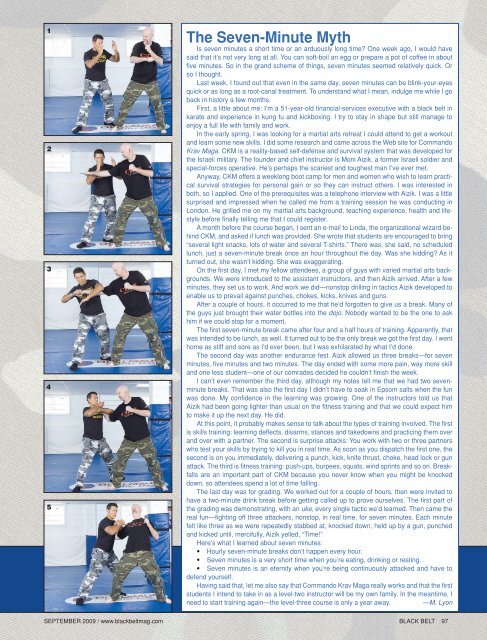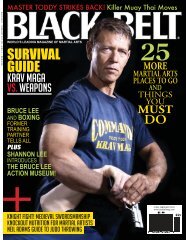Latest Black Belt Article - Commando Krav Maga
Latest Black Belt Article - Commando Krav Maga
Latest Black Belt Article - Commando Krav Maga
Create successful ePaper yourself
Turn your PDF publications into a flip-book with our unique Google optimized e-Paper software.
1<br />
2<br />
3<br />
4<br />
5<br />
The Seven-Minute Myth<br />
Is seven minutes a short time or an arduously long time? One week ago, I would have<br />
said that it’s not very long at all. You can soft-boil an egg or prepare a pot of coffee in about<br />
fi ve minutes. So in the grand scheme of things, seven minutes seemed relatively quick. Or<br />
so I thought.<br />
Last week, I found out that even in the same day, seven minutes can be blink-your-eyes<br />
quick or as long as a root-canal treatment. To understand what I mean, indulge me while I go<br />
back in history a few months.<br />
First, a little about me: I’m a 51-year-old fi nancial-services executive with a black belt in<br />
karate and experience in kung fu and kickboxing. I try to stay in shape but still manage to<br />
enjoy a full life with family and work.<br />
In the early spring, I was looking for a martial arts retreat I could attend to get a workout<br />
and learn some new skills. I did some research and came across the Web site for <strong>Commando</strong><br />
<strong>Krav</strong> <strong>Maga</strong>. CKM is a reality-based self-defense and survival system that was developed for<br />
the Israeli military. The founder and chief instructor is Moni Aizik, a former Israeli soldier and<br />
special-forces operative. He’s perhaps the scariest and toughest man I’ve ever met.<br />
Anyway, CKM offers a weeklong boot camp for men and women who wish to learn practical<br />
survival strategies for personal gain or so they can instruct others. I was interested in<br />
both, so I applied. One of the prerequisites was a telephone interview with Aizik. I was a little<br />
surprised and impressed when he called me from a training session he was conducting in<br />
London. He grilled me on my martial arts background, teaching experience, health and lifestyle<br />
before fi nally telling me that I could register.<br />
A month before the course began, I sent an e-mail to Linda, the organizational wizard behind<br />
CKM, and asked if lunch was provided. She wrote that students are encouraged to bring<br />
“several light snacks, lots of water and several T-shirts.” There was, she said, no scheduled<br />
lunch, just a seven-minute break once an hour throughout the day. Was she kidding? As it<br />
turned out, she wasn’t kidding. She was exaggerating.<br />
On the fi rst day, I met my fellow attendees, a group of guys with varied martial arts backgrounds.<br />
We were introduced to the assistant instructors, and then Aizik arrived. After a few<br />
minutes, they set us to work. And work we did—nonstop drilling in tactics Aizik developed to<br />
enable us to prevail against punches, chokes, kicks, knives and guns.<br />
After a couple of hours, it occurred to me that he’d forgotten to give us a break. Many of<br />
the guys just brought their water bottles into the dojo. Nobody wanted to be the one to ask<br />
him if we could stop for a moment.<br />
The fi rst seven-minute break came after four and a half hours of training. Apparently, that<br />
was intended to be lunch, as well. It turned out to be the only break we got the fi rst day. I went<br />
home as stiff and sore as I’d ever been, but I was exhilarated by what I’d done.<br />
The second day was another endurance fest. Aizik allowed us three breaks—for seven<br />
minutes, fi ve minutes and two minutes. The day ended with some more pain, way more skill<br />
and one less student—one of our comrades decided he couldn’t fi nish the week.<br />
I can’t even remember the third day, although my notes tell me that we had two sevenminute<br />
breaks. That was also the fi rst day I didn’t have to soak in Epsom salts when the fun<br />
was done. My confi dence in the learning was growing. One of the instructors told us that<br />
Aizik had been going lighter than usual on the fi tness training and that we could expect him<br />
to make it up the next day. He did.<br />
At this point, it probably makes sense to talk about the types of training involved. The fi rst<br />
is skills training: learning defl ects, disarms, stances and takedowns and practicing them over<br />
and over with a partner. The second is surprise attacks: You work with two or three partners<br />
who test your skills by trying to kill you in real time. As soon as you dispatch the fi rst one, the<br />
second is on you immediately, delivering a punch, kick, knife thrust, choke, head lock or gun<br />
attack. The third is fi tness training: push-ups, burpees, squats, wind sprints and so on. Breakfalls<br />
are an important part of CKM because you never know when you might be knocked<br />
down, so attendees spend a lot of time falling.<br />
The last day was for grading. We worked out for a couple of hours, then were invited to<br />
have a two-minute drink break before getting called up to prove ourselves. The fi rst part of<br />
the grading was demonstrating, with an uke, every single tactic we’d learned. Then came the<br />
real fun—fi ghting off three attackers, nonstop, in real time, for seven minutes. Each minute<br />
felt like three as we were repeatedly stabbed at, knocked down, held up by a gun, punched<br />
and kicked until, mercifully, Aizik yelled, “Time!”<br />
Here’s what I learned about seven minutes:<br />
• Hourly seven-minute breaks don’t happen every hour.<br />
• Seven minutes is a very short time when you’re eating, drinking or resting.<br />
• Seven minutes is an eternity when you’re being continuously attacked and have to<br />
defend yourself.<br />
Having said that, let me also say that <strong>Commando</strong> <strong>Krav</strong> <strong>Maga</strong> really works and that the fi rst<br />
students I intend to take in as a level-two instructor will be my own family. In the meantime, I<br />
need to start training again—the level-three course is only a year away. —M. Lyon<br />
SEPTEMBER 2009 / www.blackbeltmag.com BLACK BELT 97



